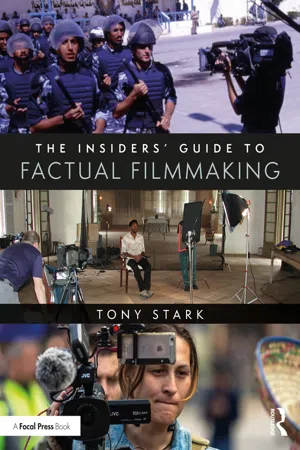You have to appreciate the many creative calls needed in the conception and the making of a documentary or current affairs film. Here are some examples:
I could be working with a producer who has his or her vision, a reporter who has his or her vision. And then I have my vision – and we won’t always see eye to eye. And you never always see eye to eye actually, there’s always tension and sometimes quite bad clashes, but I firmly believe that creative tensions and collaboration often lead to better filmmaking. You’ve got to be able to push for what you want but at the same time understand the perspective of others. And if you can collaborate, people will want to work with you as well. I think it is an extraordinarily collaborative job.
Diana Martin, Executive Producer, BBC TV, Panorama
Where and how am I going to film my interviewees? Inside? Outside? Artificially lit? Standing still? In a chair? Walking along a road? In a vehicle? And how do I frame and light my interviewees? All in close-up? Or filmed in a mixture of shot sizes? Heavily side-lit to emphasize mood? On a long lens to blur the background and focus attention on the speaker?
What other kinds of images will I need of my interviewees? I need sufficient visual material to cover commentaries that speak about them and for use as ‘overlay’ to cover edits in interviews. What will I film them doing? What’s the most appropriate image to complement my story? And how much of this imagery will I need in the film?
What other images will I need? I must give viewers a strong sense of location and illustrate the issues under discussion in my film. How and where do I shoot these images to give visual interest? And what is the best time of day to film them?
Do I need dramatic reconstruction? This can help tell a past-tense story for which no stills or archive exist. But is this approach appropriate for my film – or is the subject too sensitive for this technique? If it is justified, what style will it be filmed in? Will there be dialogue? And what are the key parts of your story that need such dramatization?
Do I want to use a presenter or reporter? If so, will they be filmed in vision or just used as an off-camera narrator? And if in vision, which parts of the story will they tell to the camera? And how much other imagery will I need of them? Will they be filmed on their own or with some of my interviewees? And, anyway, is the person I’d like to be the presenter good enough on (and off) camera to do this job?
What’s the style of the programme? Do I want to use a lot of hand-held camera to give a sense of drama, or danger? Or do I want a much more stylised approach – with beautiful compositions and the camera on a tripod for most of the shoot? Or perhaps a mixture of the two is best? Do I need any special camera equipment to achieve the images I want: A camera harness? A dolly and track? A car mount? An aerial drone camera?
Whether you’ve come straight from school, college, university or just as a freelance out of the university of life, then however good your idea, it is worth having people around you who can help you deliver it. And there is a certain amount of humility that’s required in this game to ensure that you realize that this should really be a collaborative process. And there’s nothing wrong with that. It can be really good if people are encouraging you to be the best that you can and to get the best out of what you are doing. If you haven’t done it before, I think that’s a good thing.
Tom Giles, Controller of Current Affairs, ITV
Will archive or stills enhance my narrative? If so, what’s the best place to use them in my story? And can I afford to pay the royalty fees charged for their use in my film?
How do I cut my rushes into a strong story? There are many ways of cutting a film story together. There’s no right way, just better and worse ways. Some cuts engage the viewer from start to finish. Others make them yawn and switch off after five minutes. But how do you find the best cut?
How do I transform my edited programme into a finished film? Once you have cut your story together, there’s another raft of creative decisions to take. The sound tracks have to be mixed together at a pleasing balance; you might need to adjust the colour, hue or brightness of some of the images – or blur out some faces if you’re making an investigation. All of these decisions are taken in collaboration with creative post-production staff.
None of us make a film on our own. It’s all about collaboration. If you think: ‘oh, this is my film, I’m going to make it and I’m the auteur’ the chances are you’re going to fuck up because the best ideas can come from the least expected sources. I grew up in the theatre. My mother was an actress and a stage manager in the West End. And I remember one of the things she absolutely used to say: ‘you listen to everybody whether they are t...

